ISSN 2348-1196 (print)
International Journal of Computer Science and Information Technology Research ISSN 2348-120X (online) Vol. 8, Issue 1, pp: (1-11), Month: January - March 2020, Available at: www.researchpublish.com

ISSN 2348-1196 (print)
International Journal of Computer Science and Information Technology Research ISSN 2348-120X (online) Vol. 8, Issue 1, pp: (1-11), Month: January - March 2020, Available at: www.researchpublish.com
1 , Abdul Rahman Bin Ahmad Dahlan2
12International Islamic University Malaysia, Kuala Lumpur, Malaysia
Authors Email: ramdhansuseto@gmail.com1 arad@iium.edu.my2
Abstract: This paper offers a conceptual business model of a Malaysian-based University of the Future, called MyUni, with one of its value proposition in engaging and transforming local and global communities. Globally, labor productivity and unemployment has increased to crisis levels. However, the global economy is growing at a slower rate. Increasing employment opportunities is a must, particularly for young people. This is because, fresh graduates are facing difficulties in finding jobs if they do not have the required skill and competency. The United Nations SDGs (Sustainable Development Goals) is a guideline to provide a shared blueprint for peace and prosperity for the people and the planet. This paper uses the design and system thinking methodology to understand the main problems and propose a business model of University of the Future (UotF) for MyUni in providing humanizing entrepreneurship education to the youth in Bandung, Indonesia. The contribution of this paper is a conceptual and validated business model in BMC and VPC format. The UotF business model for MyUni proposed in this paper will help youth in Bandung, Indonesia to gain the basic knowledge, skills and human values in contributing to the wellbeing and development of the community.
Keywords: Humanizing Education, Job Opportunities, Indonesia, Bandung, Business Model, BMC, VPC, SDG, Entrepreneurship.
Nowadays researchers are turning their study focusing on how Institutions of Higher Learning (IHL) to keep up the pace on the progress of the education system in the future. This is because IHL delivers education for its citizens in its country, in this case is Malaysia. Hence, the Ministry of Higher Education (MOHE) suggested the ideas to reform the education business model so as to become relevant and become the University of the Future [1]. For years, almost all university has been depending on the same education system which is not be relevance with the demand of present and future time. It is timely to change the education system so that it can optimize the full potentials of graduates and fulfill the demands of the job sectors adequately. The new concept of university digital can be highly in demand in future since it may replace the tradition university models [1]. The UN SDG 4 (Sustainable Development Goal) Quality Education says that “Ensure inclusive and equitable quality education and promote lifelong learning opportunities for all”, thus demanding universities to provide better education in nurturing balanced graduates. And SDG4 contributes to SDG 8 - Decent Work and Economic Growth, “Promote sustained, inclusive and sustainable economic growth, full and productive employment and decent work for all” make student have bigger opportunity to get decent job which can make economic in the country getting better [2]
In this paper, the study will be done in a local Malaysian university, called MyUni. This paper will propose a conceptual business model of University of the Future (UotF) for MyUni in providing humanizing entrepreneurship education and
ISSN 2348-1196 (print)
International Journal of Computer Science and Information Technology Research ISSN 2348-120X (online) Vol. 8, Issue 1, pp: (1-11), Month: January - March 2020, Available at: www.researchpublish.com
community engagement activities to the youth. This paper shall focus the youth community in Bandung, Indonesia. The new business model of MyUni is established with the vision of becoming a global university of educational excellence in human talent for the community, businesses and industries [3]. As changes are taking place, universities need to find out what should they do to attract students for quality and relevant education. Thus, this paper will provide a conceptual business model - a new BMC (Business Model Canvas) and VPC (Value Proposition Canvas) that will illustrate what the university should focus on. Ultimately MyUni will have better sight of the future and is always relevant to the people, businesses, and nations.
Artificial Intelligence (AI) will take over more than 500 million jobs by the year of 2030 [4]. Globally, labor productivity and unemployment has increased to crisis levels. However, the global economy is growing at a slower rate. Increasing employment opportunities is must particularly for young people. In order to nurture balanced graduates in the future, Malaysian universities should stay updated about the current technological. There are now a lot of online universities through which the students can get educated whenever they want and wherever they are. It is possible to ending the obligation of attending a physically existent university [3]. Those online universities are threatening to the conventional ones. Education merely cannot attract the students at present times. Because, graduates students face difficulties in finding jobs after graduating if they don‟t have any particular skill that suit with the company they apply to. This sort of skill sharpening education is far more essential than the bachelor degree [3]. For example, according to [5] vocational student that take national examination in Bandung showed 100% success rate. Conversely, 63% vocational school teachers did not have professional competencies standard and Central Bureau of Statists (BPS) state that 320.000 people add to level of employment compared from last year. White collar crime such as fraud, corruption, and embezzle money actually hard to track, because the person who did it is the one that holding high or important role in company. Moreover, internal conspiracy bound to happen without outsiders party, so they try to cover all the scandals that happen inside[6]
University need to realize the value of university degree can help student to improve their status on employment and use it to humanizing them (See Figure 1)[7]. That is why university need to be affordable and vocational and tertiary education so that the number of students who have relevant skill in their job increase which same target as SGD (Sustainable Development Goals) 4.3 and SGD 4.4. All these problems will be solved with change. Change is what university needs in order to remain relevant and survive in present time.
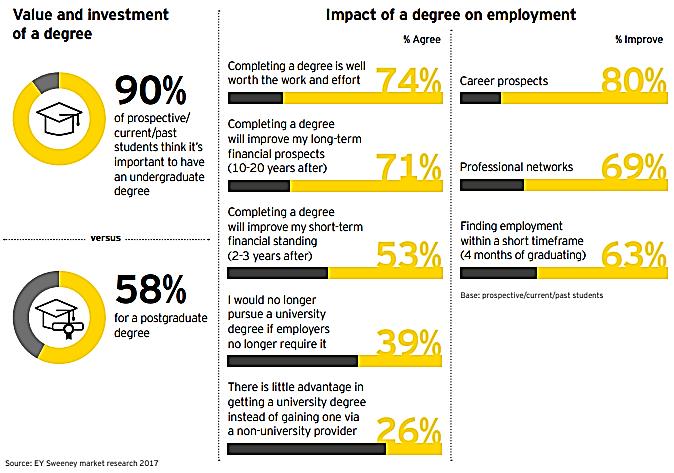
Fig. 1: Value of university degrees[7]
This paper uses the design and system thinking methodology to understand the main problems and propose a business model of University of the Future (UotF) for MyUni in providing humanizing entrepreneurship education to the youth in
ISSN 2348-1196 (print)
International Journal of Computer Science and Information Technology Research ISSN 2348-120X (online) Vol. 8, Issue 1, pp: (1-11), Month: January - March 2020, Available at: www.researchpublish.com
Bandung, Indonesia This includes literature review, interviewing with MyUni authority and utilizing business modelling tools such as business model canvas (BMC) and value proposition canvas (VPC) for probing the key problems, formulating and validating the options and finding possible humanizing education solutions. For obtaining more detail information and validation for the proposed concept, one to one interviews were conducted with the graduates so that it can reveal “facts” or truths about this research area[8]. Interviews with the people who are related to university business will have greater advantages such as OIL (Office of Industrial Link) or CPD (Centre for Professional Development). The limitation must be set so the research would not go too broad. The participant target including are graduates of MyUni from Indonesia. The new concept of BMC (Business Model Canvas) and VPC (Value Proposition Design Canvas) will also be presented.
The University campus, the library, the classroom and the customary age are mostly basic structures of advanced education, yet may not suitably toward advanced education's future. Although this reason has stayed steady for centuries, the world around advanced education experiences consistent change[9]
17 Sustainable Development Goals (SDG) adopted in 2015, SDG 4 is dedicated to quality education. Higher education is mentioned in target 4.3 and 4.4 which are by 2030, equal access for all gender to affordable, vocational and tertian education so that youth and adult have relevant skills for decent jobs. Higher education also play an important role in making significant contributions to SDG 1 - no poverty, SDG 2 - zero hunger, and SDG 8 - decent work and economic growth. SDG 4 also offers the youth the required quality education in order to become entrepreneurs who can make employment for themselves and also create jobs for others. Thus, nurturing graduates that can contribute to the creation and sustaining harmonious society by 2030.
Base on [10] humanizing education focus on the human elements in the pedagogical process, which students as a part of it have capacity for reconstructing, transforming, and reinventing themselves. Higher education got new challenges which are educating student to fulfil the demands on world globalization and preparing them to address locally or nationally base on the environment[11]. The issues are now affect everyone regardless of race, age, gender or religion. Sustainable is a vital core in humanizing education, where the main target is to building balanced graduates. Balanced graduates with the required knowledge, skills and human values that include honesty, self-sacrifice, trustworthiness, ethical, humility, and etc. [12]. Even human with education can commit crime such as money laundering, fraud, market manipulation, etc. is called white collar crimes[13]
Industry 4.0 started in 2011 for universities and private company by Germany government[14]. The Industry 4.0 is a specialization of IOT (Internet of Things). The target is to increasing productivity and efficiency of industry [15]. This is also supported by comparison to conventional industry in (see Figure 2)[16]. Maintaining association with many different industries is what university have to do to get offer the group of jobbers for graduate students. This actually helps university to enlighten what they should do to teach their student to be more skillful. If the university successfully establish the link, student will be excel themselves useful to the future
Fig. 2: Comparison of topics in conventional industrial production and the Industry 4.0[16]
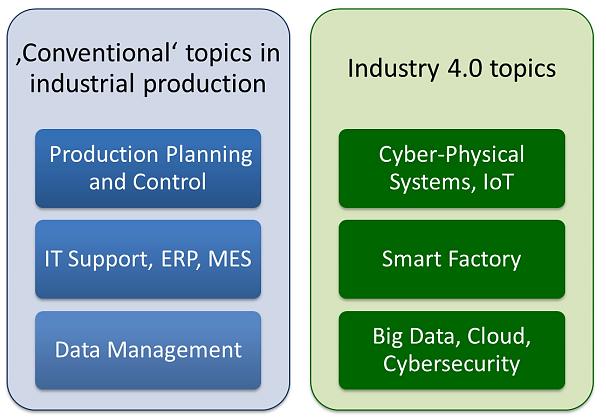
ISSN 2348-1196 (print)
International Journal of Computer Science and Information Technology Research ISSN 2348-120X (online) Vol. 8, Issue 1, pp: (1-11), Month: January - March 2020, Available at: www.researchpublish.com
Japan take the challenge of IR 4.0 and turn it into Society 5.0 from digital transformation of manufacturing into digital transformation of healthcare to take care of ageing population problem[17]. Japanese business federation published a vision paper what challenge should they tackle to becoming Society 5.0 in Figure 3[18]
Fig. 3: Society 5.0 concept[18]
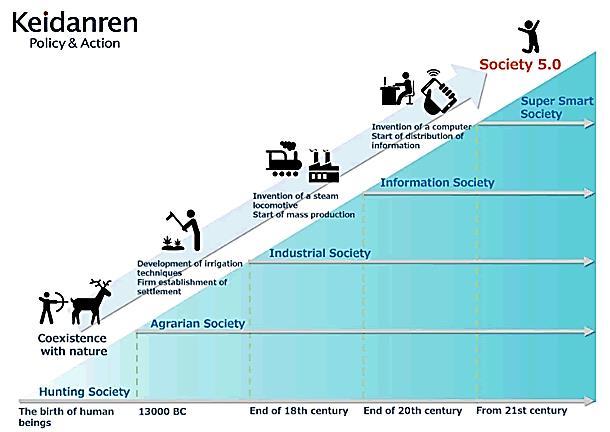
In Malaysia, the enrolment in higher education has increased over the last 10 years. The higher education environment is changing and universities need to respond to new student demands and business interests [1]. Department of Statistics Malaysia showed that the Gross Domestic Products from education has steadily increased since 2015 to 2018 by RM 14.09 billion, RM 14.84 billion, RM 15.70 billion and RM 16.62 billion respectively. This is a growth of value of roughly 7.7% annually [19]. Even though the overall education system is point in negative direction, measures should be held in this situation. University have running stream of asset and that is the student, which can be utilized to generate revenue and bring stability to university. Based on Central Agency on Statistics (BPS) provide information about employment rate from 2010-2015 (see in Figure 4)[20]. Indonesia corruption index actually getting better (see in Figure 5) but Bandung become the most highest city that commit bribe base on survey by Transparency International (see in Figure 6)[21]
Fig. 4: Labor and unemployment rate in Indonesia[20]

ISSN 2348-1196 (print)
International Journal of Computer Science and Information Technology Research ISSN 2348-120X (online) Vol. 8, Issue 1, pp: (1-11), Month: January - March 2020, Available at: www.researchpublish.com
Fig. 5: Corruption index national[21]
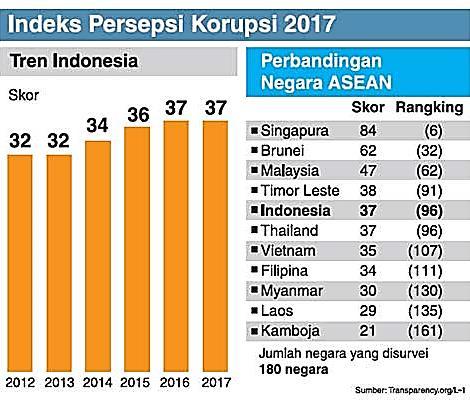
Fig. 6: Corruption index international[22]
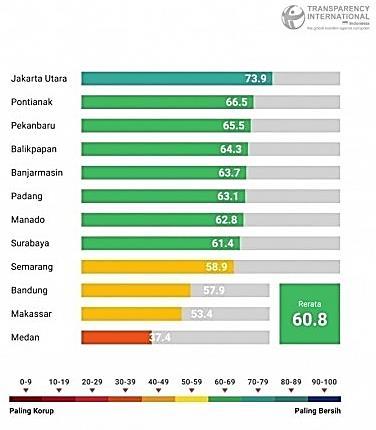
Based on [3], the key points for better university of the future are educational system and the teaching qualities should be improved and digitalized (see Figure 7). And components for BMC are value proposition, infrastructure, customers, and finances (see Figure 8) [24]
ISSN 2348-1196 (print)
International Journal of Computer Science and Information Technology Research ISSN 2348-120X (online) Vol. 8, Issue 1, pp: (1-11), Month: January - March 2020, Available at: www.researchpublish.com
Fig. 7: Business model canvas[3]
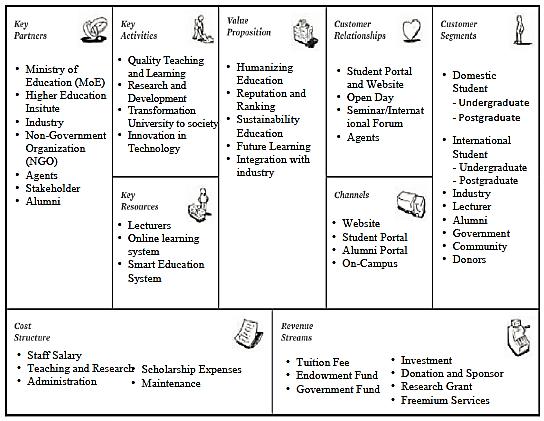
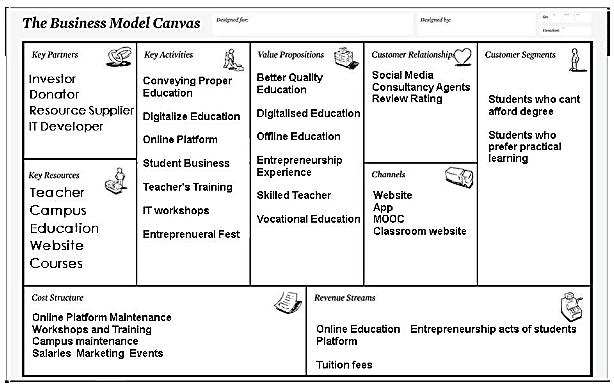
Fig. 8: Business model canvas [24]
To transform into University of the Future (UotF), university has to deal with multiple complex problems and in order to analyze those problems, business modeling tools is necessary. BMC (Business Model Canvas) and VPC (Value Proposition Canvas) are the tools used by industry to design, evaluate alternative business, models and value propositions [25]. Based on the literature review, the initial Biz Model (BMC & VPCs) of UotF is developed.
ISSN 2348-1196 (print)
International Journal of Computer Science and Information Technology Research ISSN 2348-120X (online) Vol. 8, Issue 1, pp: (1-11), Month: January - March 2020, Available at: www.researchpublish.com
Validation of the initial business modelling canvas (BMC) was conducted after interviewing relevant offices within MyUni and Indonesian students from Bandung. The target of this project is to embed moral values as part of the quality of education. Another validation of the BMC was conducted with one of the key staff in MyUni, after reviewing the initial BMC, the staff think that “face to face” discussions between lecturers and students are necessary because of personalization of learning process that cannot be achieved through online learning. Moreover, revenue is important to keep the university in operation and moving forward. Validation of the value proposition design canvas (VPC) with customer segments were conducted by interviewing 8 Indonesian student from Bandung.
Key findings from the interviewing are:
Humanizing education is important value
Quality education from process of teaching in face to face meeting
Maintaining relationship to gain mutual trust
Generating revenue is one of many ways that keep university moving
Graduates need to be able to conduct entrepreneurship.
A. BMC (Business Model Canvas)

BMC is a tool for strategic management that can be used to optimize the financial aspects of activities carried out by economic entities. BMC is the result of visualization and clearly describes all components and relationships in the business model.
Fig. 9: Enchance Business Model Canvas
ISSN 2348-1196 (print)
International Journal of Computer Science and Information Technology Research ISSN 2348-120X (online) Vol. 8, Issue 1, pp: (1-11), Month: January - March 2020, Available at: www.researchpublish.com
Value proposition is the most important tool in product marketing. Digitize the current education help lecturer to improve teaching techniques. Make better quality to teaching all the student so that they can learning while develop their ethic using Islam way to humanizing attitude. The goal to reduce poverty by providing skills and knowledge to youth and society so as to be able to develop their own jobs.
Customer segments define groups that are different from people or organizations of a company that aim to reach and serve. Youth student who want to get education so that they can get employed and self-employed/job creation for others, either for bachelor or master degree. Student who already graduate and seeking for jobs that university can help with. All this thing need fund, and that could be possible because of the donator and sponsors.
Customer Relationships aim to get new customers, retain old customers, and offer new and old products and services to new and old customers. Social media will be a media to keep the customer close. Instagram, Twitter, YouTube, etc. accounts should be kept updated. Expo can give student opportunity to seek job base on their interest. For practical skill set training, workshop is the best facilities while learning theory on internet using E-learning and E-marketplace. Workshop can also teach youth some entrepreneur skill so they can be job creator and can help another Islamic student. Giving discount can also make relationship with customer happier. And mosque as the rent place to conduct education while develop their inner heart.
Channels are a way to increase awareness, make it easier for customers to assess, help customers buy products or services, deliver products/services, and provide post-purchase assistance. E-learning and E-marketplace is the theoretical and practical way to communicate with the customer. Face to face can be arranged in mosque to educate student outside and inside. And billboard can also be optional ways to promote university.
Key partnerships can be explained as a cooperative agreement that is built between two or more companies to create value for customers. Investor from different industry will be the main entities for the key partners, cause its wider the connection for sake of student in future. Donation can be gathered for greater good for all mankind. The resource supplier companies will be providing the university with the necessary resources, such as projector, tables, chairs, etc. Lastly, the IT developer will help to develop system for the university which can be used for bringing learning and teaching purposes. BAZNAS is the only official body formed by the government in Indonesia, function of collecting and distributing zakat, infaq, and alms at the national level[26]. BAZNAS and the Government are responsible for overseeing the management of zakat based on: Islamic law, trust, expediency, justice, legal certainty, integration and accountability.
Key resources are resources that enable organizations to carry out key activities to offer value propositions, reach markets, maintain relationships with customer segments, and generate revenue. The most important resources in university are the lecturers, the campus itself and courses that determine what student will get as education. Digitize platform will be used to create E-Learning and E-marketplace platforms in either the website apps or mobile apps, representative from MYUNI staff assist in education and application creation, places for educational and practical activities, Masjid used for religious activities as well as the learning process and finally the MYUNI Alumni in Indonesia who will help handle and monitor these activities.
Key activities is the most important in the company that must be taken to operate the company successfully. The education must be digitized which students will enrolled into the university from anywhere around the world. Online platforms should be set up for teaching and learning purposes. Workshops projects will be held to discuss and exchange knowledge about the technological advancement of the world. And finally building E-Learning and E-Marketplace applications that can be used for marketing of their products and services.
ISSN 2348-1196 (print)
International Journal of Computer Science and Information Technology Research ISSN 2348-120X (online) Vol. 8, Issue 1, pp: (1-11), Month: January - March 2020, Available at: www.researchpublish.com
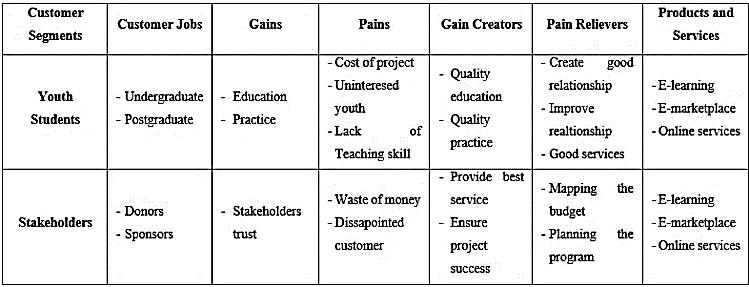
A low cost structure will be more important for some business models than other business models, so this is one of the considerations in the business. Online platform maintenance will extend the budget from the university allocation. Workshop will also be another cost for the university with a significant amount. Any events will also be part of the expenditure and the campus itself need to be maintenance.
Revenue Streams describes how organizations earn money from each customer segment. Based on [27] in Oregano State University, on campus attendance graduate students cost around $29.739 - $39.336 but for online attendance the cost is around $528 - $777 per credit. Amount of revenues can be gathered from the online education platforms. The tuition fees and graduation fees paid by the students. And another extra from advertising sponsor in campus or online platform. By making a partner who is ready to help in terms of funds namely is Badan Amil Zakat Nasional (BAZNAS), Subscription fees of entrepreneurs and individuals but no fees for entrepreneurs from poor family.
BMC is a tool for strategic management that can be used to optimize the financial aspects of activities carried out by economic entities. BMC is the result of visualization and clearly describes all components and relationships in the business model
The university has to be focus into technical education along with the proper deliverance of education. Students can catch up the class that is being absent with seeing the recorded classroom sessions. Some of customer problem explained in the customer jobs (see in Table 1) such as:
Making business
Improve skill and knowledge
Learn new technology
Online classes are vital so it has to be well structured and organized. The lecturers has to be skillful and experience respectively. The education has to be digitalized.
ISSN 2348-1196 (print)
International Journal of Computer Science and Information Technology Research ISSN 2348-120X (online) Vol. 8, Issue 1, pp: (1-11), Month: January - March 2020, Available at: www.researchpublish.com
Online or offline classes can be attended. The education is vocational so it will fulfil certain skills that will be required in the job fields. Lecturer will record the class presentation and upload it.
Digitize make education more effective for student to learning. The knowledge will have relation with the practical world. Lecturer with skillful and work experience will give newest relevant education.
Easier education make study more accessible for both online and offline students. It will be affordable for those who are being disadvantaged from education.
Most of the students today cannot pay for college degree. A problem that persists is the lecturer lack of enough training provided by the university or inexperience what currently need in the real world. No more excuse for missing the class because of the real or lie reason.
This paper offers a conceptual business model of University of the Future, MyUni, with one of its value proposition in engaging and transforming local and global communities. Increasing employment opportunities is a must, particularly for the youth. This is because, fresh graduates are facing difficulties in finding jobs if they do not have the required skill and competency. The contribution of this paper is a conceptual and validated business model in the form of BMC and VPC. The UotF business model for MyUni proposed in this paper will help youth in Bandung, Indonesia to gain the basic knowledge and skills with human values such as Al-Amanah (Trustworthy). Thus, enhancing job opportunities for employment while reducing corruptions and white collar crime rates. This will lead and contribute SDG 4 and SDG 8 as well as to the wellbeing and development of the community in Bandung, Indonesia.
For future work, the researchers recommend to conduct interviews with more stakeholders and enhancing this paper further. This could help other researcher as their guideline in the same topic. In future, the researchers will formulate and establish the Project and Change Management Plan in implementing the conceptual business model of MyUni.
[1] N. Z. Yahaya and A. R. A. Dahlan, “University of the Future ( UotF ): Redesign Business Model for Local University in Malaysia through Humanising Education and 4IR,” Int. J. Sci. Res., vol. 8, no. 1, pp. 64–70, 2019.
[2] U. Nations, “Sustainable Development Goals Knowledge Platform,” 2018. [Online]. Available: https://sustainabledevelopment.un.org/. [Accessed: 25-Nov-2019].
[3] M. N. Haque, N. Nibraz, and A. R. A. Dahlan, “A Conceptual Model to Digitally Transform UTAR,” vol. 6, no. 2, pp. 198–205, 2018.
[4] S. Makridakis, “The forthcoming Artificial Intelligence (AI) revolution: Its impact on society and firms,” Futures, vol. 90, pp. 46–60, 2017.
[5] S. Nurlatifah and D. A. Kurniady, “Quality of Vocational School Education in Bandung City,” vol. 258, no. Icream 2018, pp. 390–395, 2019.
[6] M. Zulhermawan, “TINDAK KEJAHATAN KORUPSI WHITE COLAR CRIME MODEL TREND DAN PENYEBABNYA,” vol. 55, pp. 55–69, 2019.
[7] E. Young, “Can the universities of today lead learning for tomorrow ? Executive summary,” 2018.
[8] D. Hatton MacDonald, R. Bark, A. MacRae, T. Kalivas, A. Grandgirard, and S. Strathearn, “An interview methodology for exploring the values that community leaders assign to multiple-use landscapes,” Ecol. Soc., vol. 18, no. 1, 2013.
ISSN 2348-1196 (print)
International Journal of Computer Science and Information Technology Research ISSN 2348-120X (online) Vol. 8, Issue 1, pp: (1-11), Month: January - March 2020, Available at: www.researchpublish.com
[9] F. Faizan, A. Ghafari, M. Hussein, and A. R. A. Dahlan, “University of the Future: A Conceptual Business Model of University Putra Malaysia,” Int. J. Comput. Sci. Inf. Technol. Res., vol. 6, no. 2 (April-June), pp. 206–216, 2018.
[10] A. Balyer and K. Özcan, “Roles of physical, pedagogical environment and leadership practices toward humanizing education: Teachers‟ views,” Elem. Educ. Online, vol. 18, no. 3, pp. 1233–1243, 2019.
[11] S. Bakhtiari and H. Shajar, “Globalization and Education: Challange And Opportunities,” Education, vol. 50, no. 4, pp. 1–13, 2009.
[12] F. Winasis and A. R. A. Dahlan, “Reshaping University of the Future : Designing Business Models that are Relevant through Humanising Education and 4IR,” vol. 7, no. 1, pp. 1–12, 2019.
[13] N. Ryder, “White Collar Crime – a serious threat or an inconvenience,” 2014.
[14] M. Monattin, “IR4.0: On the brink of technological revolution,” 2019. [Online]. Available: https://www.thestar.com.my/business/business-news/2019/05/25/ir40-on-the-brink-of-technological-revolution. [Accessed: 15-Dec-2019].
[15] A. G. Frank, L. S. Dalenogare, and N. F. Ayala, “Industry 4.0 technologies: Implementation patterns in manufacturing companies,” Int. J. Prod. Econ., vol. 210, no. January, pp. 15–26, 2019.
[16] A. Rojko, “Industry 4.0 concept: Background and overview,” Int. J. Interact. Mob. Technol., vol. 11, no. 5, pp. 77–90, 2017.
[17] Leungchopan, “From Industry 4.0 to Society 5.0: the big societal transformation plan of Japan,” 2017. [Online]. Available: https://www.i-scoop.eu/industry-4-0-society-5-0/. [Accessed: 15-Dec-2019].
[18] Keidanren, “Toward realization of the new economy and society,” Policy & Action, vol. 2016, 2016.
[19] S. HAMISAH TAPSIR, “Higher education as an industry,” The Star Online, 2019. [Online]. Available: https://www.thestar.com.my/news/education/2019/08/18/higher-education-as-an-industry. [Accessed: 28-Oct-2019].
[20] I. Invesment, “Pengangguran di Indonesia,” 2019. [Online]. Available: https://www.indonesiainvestments.com/id/keuangan/angka-ekonomi-makro/pengangguran/item255. [Accessed: 15-Dec-2019].
[21] D. Rosalina, “Indeks korupsi nasional membaik, Bandung malah jadi kota paling tinggi suap,” KONTAN.CO.ID, 2018. [Online]. Available: https://nasional.kontan.co.id/news/indeks-korupsi-nasional-membaik-bandung-malahjadi-kota-paling-tinggi-suap. [Accessed: 29-Dec-2019].
[22] C. D. Simbolonl, “Riuh OTT,Indeks Korupsi Stagnan,” 2018. [Online]. Available: https://mediaindonesia.com/read/detail/146517-riuh-ott-indeks-korupsi-stagnan. [Accessed: 29-Dec-2019].
[23] R. Susilana, L. Dewi, and M. Ali, “A Study on the need of entrepreneurship local content curriculum in Bandung Senior High School,” IOP Conf. Ser. Earth Environ. Sci., vol. 245, no. 1, 2019.
[24] A. I. Nasution, A. R. A. Dahlan, J. Ibrahim, and N. M. Alwi, “Redesigning the University of the Future (UotF) through Humanizing Education and Industry Revolution 4.0,” International Journal of Interdisciplinary Research And Innovations Vol. 6, no. 4, pp. 464–472, 2018.
[25] J. Ibrahim and A. R. A. Dahlan, “Designing business models options for „University of the Future,‟” Colloq. Inf. Sci. Technol. Cist, no. August 2017, pp. 600–603, 2017.
[26] M. Wahyu, R. Pratama, and A. R. A. Dahlan, “The Conceptual Humanizing Entrepreneurship Programme : Creating job opportunities for the unemployed youth and to reduce poverty in Kediri , East Java,” vol. 7, no. 2, pp. 34–42, 2019.
[27] S. Lee, “How Online College Can Cost Less Than a Campus Program,” 2019. [Online]. Available: https://www.accreditedschoolsonline.org/resources/cost-of-online-learning/. [Accessed: 02-Dec-2019]